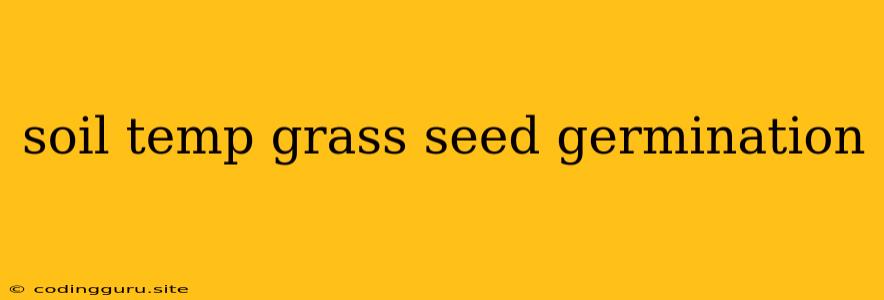The Critical Role of Soil Temperature in Grass Seed Germination
Have you ever wondered why your grass seed just doesn't seem to be sprouting, even though you've followed all the instructions on the package? The answer might lie in soil temperature. Soil temperature is a critical factor that influences grass seed germination, and understanding it can be the key to a lush, green lawn.
Why Is Soil Temperature Important?
Grass seed germination is a complex process that involves the seed absorbing water, swelling, and eventually sprouting a root and shoot. This process is highly sensitive to temperature, and each grass species has an optimal temperature range for germination.
Think of it like this:
- Too cold: Just like humans shiver in the cold, seeds need a certain warmth to kickstart their growth process. If the soil temperature is too cold, the seed's metabolism slows down, and it may not have enough energy to germinate.
- Too hot: On the other hand, extreme heat can damage the seed's delicate tissues and prevent germination.
What is the Ideal Soil Temperature for Grass Seed Germination?
Most common cool-season grasses, such as Kentucky bluegrass, perennial ryegrass, and fescue, germinate best in temperatures between 50°F and 75°F (10°C to 24°C). Warm-season grasses like Bermuda, zoysia, and centipedegrass prefer warmer temperatures, typically between 70°F and 90°F (21°C to 32°C).
How to Monitor Soil Temperature
You can use a soil thermometer to accurately measure the soil temperature. Insert the thermometer about 2-3 inches into the soil, and take the reading after a few minutes. You can also find helpful resources online that provide average soil temperature data for your region.
Tips for Optimizing Soil Temperature for Grass Seed Germination
- Timing is Everything: The best time to sow cool-season grasses is in the early fall or spring, when the soil temperature is ideal. For warm-season grasses, planting in the late spring or early summer is recommended.
- Cover the Seeds: Applying a thin layer of mulch (straw or compost) over the seedbed can help regulate soil temperature and prevent excessive drying. This creates a more favorable environment for germination.
- Water Consistently: Maintaining consistent moisture is crucial for seed germination. Water the soil deeply and regularly, but avoid overwatering, which can lead to compaction and hinder root growth.
- Choose the Right Grass Species: Consider your climate zone and the type of grass that thrives in your region. This will ensure that you choose a grass variety that is well-suited to the local soil temperature and other environmental factors.
Common Issues Related to Soil Temperature
- Slow or Uneven Germination: If the soil temperature is too cold or too hot, germination may be slow or uneven. This can lead to a patchy lawn.
- Seed Rot: In overly wet conditions, seeds can rot before they have a chance to germinate. Proper drainage and aeration are essential to prevent this.
- Delayed Growth: If the soil temperature is too cold, seedlings may be slow to emerge. This can make them more vulnerable to pests and diseases.
Conclusion
Soil temperature is a crucial factor that influences grass seed germination. Understanding the ideal temperature range for your chosen grass species and taking steps to optimize it can significantly improve your chances of a successful lawn establishment. By following the tips and strategies outlined above, you can create a thriving lawn that will provide years of beauty and enjoyment.
